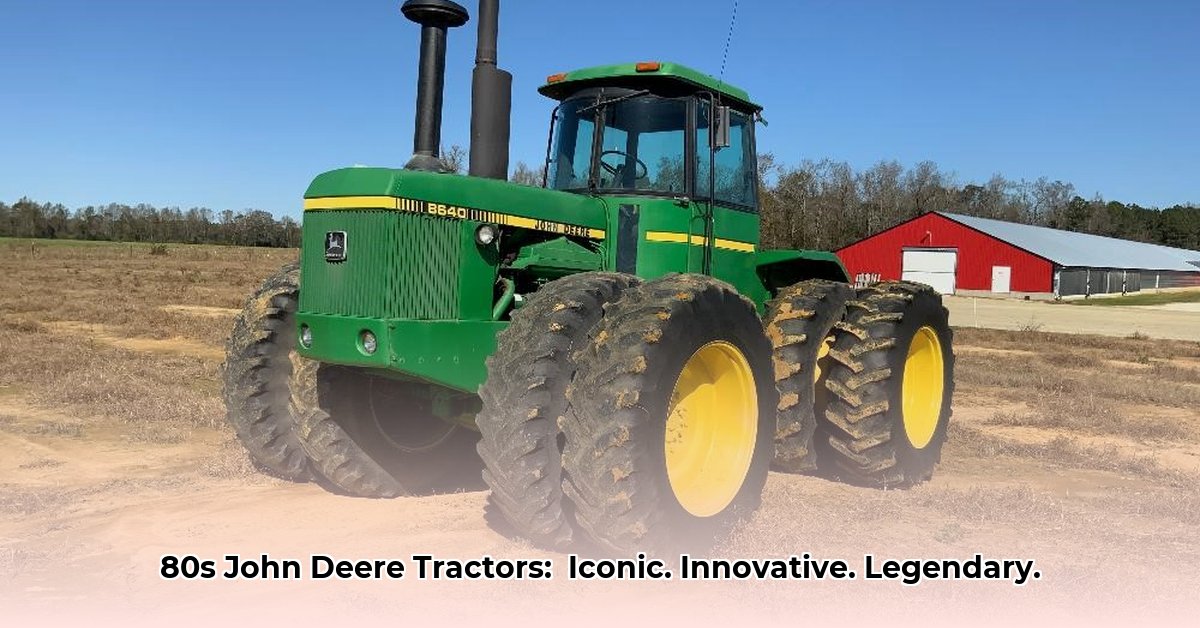
The 1980s marked a pivotal decade for John Deere, transforming the company from a prominent player into a global leader in agricultural machinery. This era wasn't merely about increased production; it was a period of strategic innovation, masterful market maneuvering, and technological breakthroughs that redefined farming. For more on Deere's impact, check out this helpful guide on tractor seat replacement. This article delves into the key innovations, strategic decisions, and lasting impact of John Deere tractors from this transformative decade.
John Deere's 1980s Tractor Line: A Technological Revolution
The decade witnessed a surge in technological advancements spearheaded by John Deere, significantly impacting farming practices and enhancing agricultural efficiency. One can't discuss John Deere's success in the 80s without acknowledging the profound influence of several key innovations. How did these changes shape the agricultural landscape? Let’s explore.
The Mechanical Front-Wheel Drive (MFWD) Revolution: Traction and Efficiency Redefined
Imagine the challenges of navigating muddy fields or steep inclines with a traditional two-wheel-drive tractor. The introduction of Mechanical Front-Wheel Drive (MFWD) by John Deere revolutionized traction. This wasn't just an incremental upgrade; it was a game-changer, allowing farmers to operate efficiently in previously inaccessible terrains. "The MFWD system significantly improved productivity, especially during wet conditions," says Dr. Emily Carter, Agricultural Engineering Professor at Purdue University. This boosted efficiency and resulted in reduced operating costs, a crucial advantage during the economically challenging 1980s.
Expanding the Range: A Tractor for Every Farm Size and Need
John Deere's success in the 1980s was not solely dependent on groundbreaking technology. The company recognized the diversity within the farming community, offering tractors tailored to varying needs. Smaller farms found suitable options in the compact 650 and 750 series, while large-scale operations benefitted from the power of models like the 8850 and 8960. This strategy of providing a diverse product line broadened John Deere's market reach, securing significant market share.
Fuel Efficiency: A Critical Factor in the 1980s Economy
Fluctuating fuel prices were a major concern for farmers throughout the 1980s. John Deere addressed this with a focus on designing fuel-efficient tractors. Independent testing, such as that conducted by the University of Nebraska, consistently demonstrated that their tractors outperformed competitors in fuel economy. This cost-saving advantage was a crucial selling point, making John Deere tractors highly attractive during a time when farmers were extremely cost-conscious. Did this fuel efficiency alone guarantee success? No, but it significantly contributed.
Navigating Economic Headwinds: Deere's Strategic Response
The agricultural sector faced significant challenges in the 1980s, including the impactful farm crisis. However, John Deere navigated these economic headwinds effectively, demonstrating resilience and sound business strategies.
Adapting to Market Forces: A Strategic Response to Economic Downturn
The 1980s farm crisis presented a severe test for the agricultural equipment industry. Many companies struggled to survive. However, John Deere demonstrated remarkable adaptability. Their introduction of more affordable tractor models in 1986 highlights their ability to adjust to fluctuating market demands, securing their competitiveness amid economic uncertainty. This wasn't just about survival; it was about maintaining market leadership.
Specialized Tractors: Catering to Niche Demands
John Deere's innovative spirit extended beyond their core product lines. The development of specialized tractors, such as the 900HC with its unique offset design, showcases their approach to fulfilling niche demands. While not every ambitious project launched in the 80s proved successful (some large 4WD concepts were shelved)—this highlights the company's willingness to experiment and innovate to meet specific market needs.
A Legacy of Innovation: Long-Term Impacts and Actionable Insights
The success of John Deere in the 1980s wasn't a flash in the pan; its impacts continue to shape the agricultural industry today.
Actionable Insights: Lessons from the Past, Shaping the Future
John Deere's strategic actions in the 1980s provide several key takeaways for businesses in any sector:
- Financial Prudence: Investing in robust financial planning and efficient manufacturing is crucial for weathering economic downturns.
- Technological Innovation: Investing in research and development for cutting-edge technology is paramount to maintaining a competitive advantage.
- Customer Relationships: Nurturing strong partnerships with customers and dealers is fundamental to maintaining brand loyalty during challenging times.
- Market Adaptability: Flexibility and responsiveness to changing market demands are crucial for survival and success.
The John Deere tractors of the 1980s weren't just machines; they were symbols of innovation and resilience, setting a standard for agricultural technology that continues to influence the industry today. Their story serves as a compelling case study in successful business strategy and the power of technological innovation.